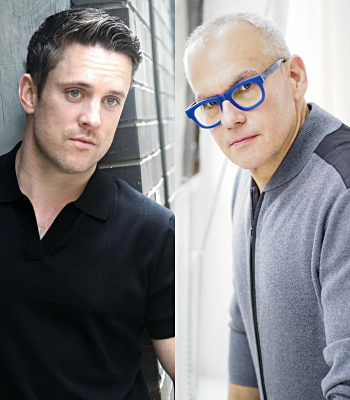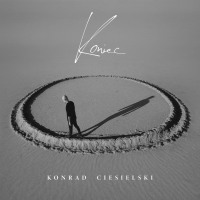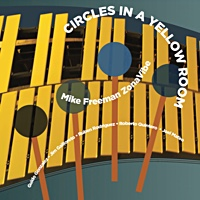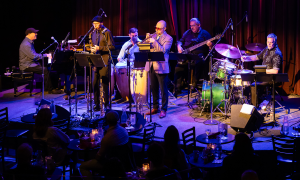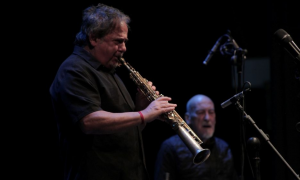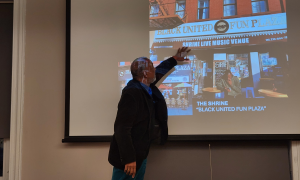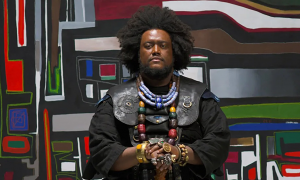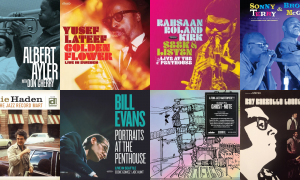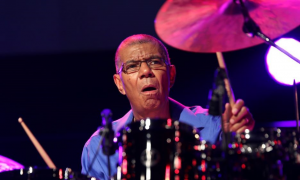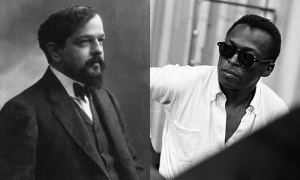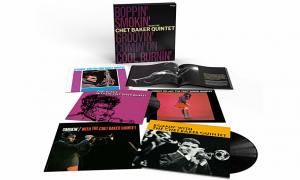Home » Jazz Articles » Live Review » The Respect Sextet at Le Poisson Rouge
The Respect Sextet at Le Poisson Rouge
The set list featured several Sun Ra classics, including 'Saturn' and 'Angels and Demons at Play,' along with a number of works by Stockhausen arranged for the particular instrumentation of the sextet.
Le Poisson Rouge
New York City
May 24, 2009
After nearly a decade together, the members of The Respect Sextet have created an environment of trust and musical courage that allows them to explore the many facets of improvised music. They displayed this fearlessness—and a playful love of experimentation—to a standing-room-only crowd at Le Poisson Rouge in New York's Greenwich Village on May 24.
The Respect Sextet consists of Eli Asher (trumpet), James Hirschfeld (trombone, electronics), Malcolm Kirby (bass), Ted Poor (drums), Josh Rutner (saxophone, bass clarinet), and Red Wierenga (piano, keyboards, laptop, electronics). They got together when they were students at the Eastman School of Music in Rochester, NY. For several years they played a regular weekly gig in a coffee shop next to the school, and this gave them the workshop environment they needed to develop both their approach to performing and their composition and arranging skills.
The show at Le Poisson Rouge was a CD release party to promote Sirius Respect (Mode, 2009), a recording that features the music of two avant-garde giants—Sun Ra and Karlheinz Stockhausen. The set list featured several Sun Ra classics, including "Saturn" and "Angels and Demons at Play," along with a number of works by Stockhausen arranged for the particular instrumentation of the sextet.
None of Stockhausen's works were originally written for an ensemble such as Respect, but the band managed to find pieces that leant themselves to their brand of collective improvisation. Many of the Stockhausen pieces were paired in medleys with the Sun Ra compositions, which allowed for long stretches of freely improvised transitions between the tunes. Given the musical freedom inherent in many of the compositions, that often made it difficult to figure out where one piece began and another ended. Not that that mattered, of course, given the seamless integration of the performances.
Perhaps the most successful combination was the final medley—a blending of Stockhausen's "Capricorn" (from his series of composition based on signs of the Zodiac) with Sun Ra's "Saturn." The highlight of this pairing was Eli Asher's trumpet solo. Asher has described himself as the band's bebopper, and those roots were clearly present in his improvisation. But he has also pushed himself far beyond those original boundaries, as his blistering solo made clear. Also impressive was the cloud of mist surrounding him in the harsh yellow light of the stage. Asher seemed to be creating his own steam from his mouthpiece and bell as he tore through his performance.
Pianist Wierenga also impressed with his palette of electronic and acoustic instruments. Sitting like a mad scientist amid keyboards, laptops, electromagnets and a grand piano, Wierenga was responsible for many of the subtle orchestrations and soundscapes of the concert. Since studying in Amsterdam several years ago, Wierenga has begun building his own musical devices, several of which were on display. Hirschfeld blew into a wooden box with trumpet-like valves that ran through a laptop, producing eerie synthetic pads behind the improvisations. Rutner used one of Wierenga's crackleboxes, a wooden box with buttons on the front that made various 70s-era Nonesuch bleeps and bloops when pressed. And Wierenga himself altered his piano sounds with various electronic gadgets and laptop effects.
Wierenga's electronic experimentation was equaled by his piano constructions. Although perhaps "deconstructions" would be a better descriptive term. Wierenga is more than capable of ripping out agile bop piano lines, as he proved on several numbers, but he specializes in taking apart a song's melodic and harmonic structure and stripping it down to its component parts. This involves an impressive ability to analyze a piece on the spot and then creatively—and musically—get to its heart.
Driving the band was the unstoppable engine of Kirby and Poor. After so many years together, the bassist and drummer have developed into a rock-solid unit. They were able to drive the band through powerhouse performances like the opener, Ra's "Shadow World," while also subtly coloring the free improvisations.
Trombonist James Hirschfeld brings soul and depth to his instrument, forcing a massive sound from the end of his horn. He's a skilled composer, both on paper and in the moment as an improviser. But Hirschfeld, like all the members of the sextet, is always ready to act for the greater good of the ensemble and the music. He strides to front when necessary, and then crouches on the floor blowing into an electro-acoustic box, nearly unseen, when it suits the composition.
Running throughout this ensemble is a strong sense of humor and joy. Saxophonist Rutner epitomizes this playfulness, although he's also a serious improviser and composer. Rutner seldom cracks a smile on stage, even when he's slamming a canvas tote bag full of percussion instruments on the floor or blowing the shofar—a Jewish horn that it is used for serious religious purposes, but is after all a large ram's horn. Rutner was also responsible for the recorded introductory piece that brought the band on stage. The recording featured the voices of Sun Ra and Stockhausen, along with audio from a Mentos commercial, chords from a Beatles album, and a count-off from educator Jamey Aebersold.
The Respect Sextet is that rare jazz animal—a band that has stayed together. On stage at Le Poisson Rouge, the band proved that longevity has its place, and that six friends can combine forces into a whole that is truly worthy of its parts.
Tags
PREVIOUS / NEXT
Support All About Jazz
 All About Jazz has been a pillar of jazz since 1995, championing it as an art form and, more importantly, supporting the musicians who make it. Our enduring commitment has made "AAJ" one of the most culturally important websites of its kind, read by hundreds of thousands of fans, musicians and industry figures every month.
All About Jazz has been a pillar of jazz since 1995, championing it as an art form and, more importantly, supporting the musicians who make it. Our enduring commitment has made "AAJ" one of the most culturally important websites of its kind, read by hundreds of thousands of fans, musicians and industry figures every month.










